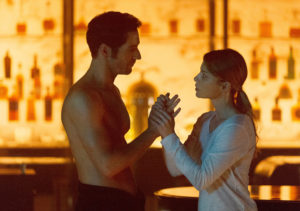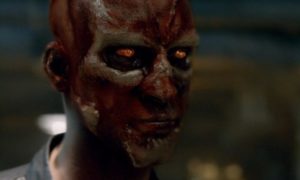“Manly Whatnots” was a more enjoyable episode of Lucifer, and it may be something of a shifting point in the season. The first half of Lucifer’s fourth episode focuses on Lucifer’s incessant pursuit of Chloe’s affections. Whereas in the comics we see Lucifer occasionally engage in sexual congress (most significantly with Mazikeen, the one with a place in his hard heart), in the TV show Lucifer is rather oversexed, and Chloe being the one mortal woman immune to Lucifer’s devilish charm naturally makes her bear the brunt of his arrogant sexual advances. The debauched Devil is both frustrated and challenged by the enigmatic Chloe, and the first half of “Manly Whatnots” is given over to Lucifer lusting after Chloe in the hope that bedding her will relieve him of his angst.
 The episode becomes interesting during its second half, however, when Lucifer attempts to tempt Chloe by standing before her nude. The bashful Chloe happens to catch a glimpse of Lucifer’s back, which reveals the scars where his wings (shorn by Mazikeen rather than Morpheus in this version) once were. When Chloe tries to touch these literal scars of Lucifer’s past, the fallen angel becomes quite vulnerable, and it made for a rather refreshingly somber moment.
The episode becomes interesting during its second half, however, when Lucifer attempts to tempt Chloe by standing before her nude. The bashful Chloe happens to catch a glimpse of Lucifer’s back, which reveals the scars where his wings (shorn by Mazikeen rather than Morpheus in this version) once were. When Chloe tries to touch these literal scars of Lucifer’s past, the fallen angel becomes quite vulnerable, and it made for a rather refreshingly somber moment.
It was also reassuring to see Mazikeen (she is actually referred to by her full name) in action, exchanging blows with Amenadiel, who tries to establish common ground with Lucifer’s guardian demon. Pinned up against a pillar in Lux, Mazikeen in a rather feral moment ends the scuffle with Amenadiel by licking his face, and the aroused angel is obviously caught unaware. It was quite an unexpected moment for the viewers as well, leaving us guessing about the various possibilities. Might Mazikeen try to seduce and manipulate the angel who is trying to manipulate her to get Lucifer to return to Hell? Might Mazikeen and Amenadiel become romantically involved, underlining the ambivalence of the angelic-demonic struggle?
 As many supernatural positives as “Manly Whatnots” provided, Lucifer flashing his demonic face to frighten this week’s perpetrator was one significantly negative moment. Lucifer had done this in the opening scene of the second episode (“Lucifer, Stay. Good Devil”), but there it appeared to be a joke; here, it seemed serious. What was wonderful about the Lucifer comic was that it mirrored Romantic renditions of Milton’s Satan in the visual arts by portraying the fallen angel as a beautiful figure—blonde-haired, golden-eyed, and smooth-faced. It would be a shame if the TV series undid this and went for the Devil’s handsomeness as a false face hiding his true monstrousness. The sight of Lucifer’s demonic face was particularly jarring for following one of Lucifer’s one-liners minutes before, when the Devil explained to the doubting Chloe that he cannot provide proof of his true identity by tail or horns, “the stuff of TV and movies. They always get it wrong.” Indeed…
As many supernatural positives as “Manly Whatnots” provided, Lucifer flashing his demonic face to frighten this week’s perpetrator was one significantly negative moment. Lucifer had done this in the opening scene of the second episode (“Lucifer, Stay. Good Devil”), but there it appeared to be a joke; here, it seemed serious. What was wonderful about the Lucifer comic was that it mirrored Romantic renditions of Milton’s Satan in the visual arts by portraying the fallen angel as a beautiful figure—blonde-haired, golden-eyed, and smooth-faced. It would be a shame if the TV series undid this and went for the Devil’s handsomeness as a false face hiding his true monstrousness. The sight of Lucifer’s demonic face was particularly jarring for following one of Lucifer’s one-liners minutes before, when the Devil explained to the doubting Chloe that he cannot provide proof of his true identity by tail or horns, “the stuff of TV and movies. They always get it wrong.” Indeed…
Interestingly, just as Lucifer convinces Chloe to fire a shot at him to prove his immortality, a bemused Lucifer finds himself in pain and bleeding. On the mortal plane, Lucifer appears to not only be vulnerable to human feelings, but human frailty as well. Mazikeen panics at the unsuspected danger, pleading with Lucifer to leave the earthly fun-and-games well enough alone and return home to Hell. The jaded immortal Lucifer, however, appears rather excited by the prospect of feeling mortal danger. “The fun’s just begun,” Lucifer utters with a smirk as the episode draws to a close.
Episode 4 of Lucifer may be the gateway to the show’s exploration of some of the more supernatural or mythological aspects of the subject matter, which is what I’m hoping for. On the other hand, the Lucifer-becoming-human angle could abdicate the supernatural altogether. Let’s hope that this is not the case. If nothing else, the “Manly Whatnots” episode of Lucifer provided grounds for “cautious optimism,” to quote Mike Carey’s Lucifer Morningstar.1
Notes
1. Mike Carey, Lucifer: A Dalliance with the Damned (New York: DC Comics, 2002), p. 65.↩